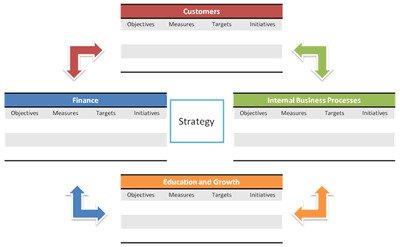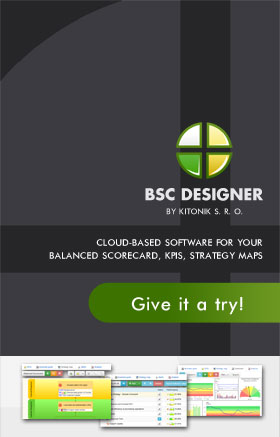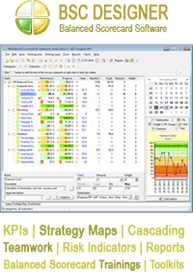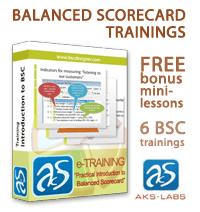SWOT and Balanced Scorecard
Before we go in to the details of the balanced Scorecard method and compare it to the SWOT analysis, let’s take a look at the BSC (Balanced Scorecard) and define what it is, what it does and how it differs from the SWOT analysis.
BSC is a strategic planning and implementation tool that assists management in the process of achieving organizational goals. It is a method that enables cooperation and synchronization in the business procedures. Typically, balanced Scorecard consists of several fields (usually 4), which lists the subject of interest and the steps that would allow the company to reach highest results in the listed fields.
A simple version of a basic BSC is illustrated below.
Balanced Scorecard
As you can see, there are four fields: financial, internal business procedures, learning and growth and customers. We will discuss each one of them in little more detail in order to give you a better understating of how the method works.

The SWOT analysis is a part of Balanced Scorecard process needed when you define company's strategy goals
Financial; in this section managers list some of the key steps and goals they need to achieve in order to succeed in their ultimate goal. Steps might be lowering fixed costs, low leverage, possible IPO etc. As for the internal business process, it might involve training, better communication, changing organizational structure, etc. For the learning and growth, it might outline the process of training, growth strategies (acquisition, franchising), and target market share. As far as the customers are concerned, management might define the strategy for increasing customer satisfaction, brand development, and advertising.
What is important to understand is that, there is a difference between the SWOT and BSC. While the SWOT analysis is mostly used in the broader planning procedures, such as strategic goals for the organization, BSC is a tool that has often been used in the process of achieving a specific goal. To make it clear, SWOT is used to define the goal, and the BSC is used to design a plan to achieve that goal.
BSC is not strictly limited to this particular purpose and can be successfully used in a broader planning; but we have found that the method is most appropriate and useful when planning for a particular strategy and steps for implementing it.
While the design presented above is not a standard one, most frequently we encounter 4 field designs. An alternative design is presented below.
SWOT and BSC have been in use for several decades and have proved to be effective and efficient methods in business planning.
The two methods have frequently been viewed as competitors, but the consensus has been emerging in the academic as well as the professional community that the two are more complementary to each other than they are rivals.
Both methods are relatively cheap to design and implement, and provide a valuable insight in to the key aspect that will determine the organization’s success.
In conclusion it has to be mentioned that, BSC and SWOT are two methods that help define goals, steps, and an overall organizational strategy; they both have been used successfully for several decades. Even in the modern age of technology and alternative methods, these two simple graphic charts have been very popular among the top executives.
The full version of SWOT Guide includes:
- 21 PowerPoint templates for SWOT presentation
- 28 pages SWOT Analysis Guide that includes
- Learn more about Business Analysis Toolkit full version


